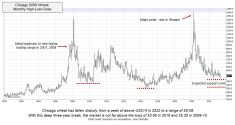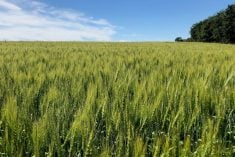Over the past 30 days, most of Ontario has received 60-85 per cent of normal precipitation. However, the region from Toronto south to Windsor is relatively dry.
Quick look
Soybeans: The 2021 U.S. soybean crop is expected to be much larger than in 2020.
Corn: Demand for corn for cattle finishing is hitting seasonal highs.
Wheat: Ontario wheat is rated at 73 per cent good to excellent.
The bulk of this area has received 40-60 per cent of normal precipitation with some pockets reporting less than 40 per cent. Planting progress has accelerated over the past couple weeks and is slightly ahead of normal.
Read Also

Scouting advised for soybean aphids
Soybean aphids have been spotted in a few fields in southern Ontario that haven’t seen soybean aphids in quite a…
Ontario farmers had planted about 65 per cent of the corn and 50 per cent of the soybeans as of May 18. Winter wheat is in the flag to jointing state. Temperatures have been two to four degrees below normal during the first half of May. Warmer temperatures are in the forecast but timely rains are needed to sustain yield potential.
As of May 16, United States farmers had planted 61 per cent of the soybean crop, which compares to last year’s pace of 51 per cent and the five-year average of 37 per cent. U.S. corn planting progress was estimated at 80 per cent compared to the year-ago pace of 51 per cent and the five-year average of 37 per cent.
An earlier-than-normal planting timeframe is associated with above-average or trend-type yields. In Argentina, the corn harvest is about 25 per cent complete, down from 40 per cent last year and the five-year average of 33 per cent. Argentine soybean harvest is 70 per cent complete compared to 87 per cent last year and the five-year average of 74 per cent.
Brazil’s safrinha corn crop continues to experience adverse dry conditions during the main pollination stage. The Brazilian soybean harvest is finished and the safrinha corn harvest will move into full swing in late June.
The Ukraine corn crop is about 74 per cent planted.
The U.S. Department of Agriculture’s World Agriculture Supply and Demand Estimates (WASDE) report for May was considered neutral for the grain and oilseed markets. At this stage, the USDA uses trend line yields to project 2021 production for U.S. crops. Above-average yields are expected for U.S. winter wheat. Brazilian and Argentine corn and soybean offers are more competitive than U.S. origin for June, July and August. U.S. export sales for old crop positions have slowed although China has been buying U.S. new crop corn.
The Canadian dollar reached up to US83 cents on May 12, the highest level since September of 2017. Rising commodity prices and growing exports bode well for the resource-based currency.
The Bank of Canada has a relatively hawkish tone compared to the U.S. Federal Reserve. Canada has no bragging rights but U.S. fiscal policy is negative. Jobless benefits and direct relief payments are said to have stunted job growth despite 8.1 million job openings.
Soybeans
At the time of writing this article on May 17, Ontario old crop soybean prices were at $19.75 per bushel, while new crop bids were hovering around $16.60 per bushel. Old crop soybean stocks will be historically tight due to the year-over-year increase in export and domestic demand. Farmer selling has been rather light through the planting period but there is a tendency to clean out bins during June and July.
Canadian export offers out of the St. Lawrence are about US$25 per tonne premium to offers out of the U.S. Gulf of Mexico and about US$40 per tonne premium to Brazilian f.o.b. offers. Exporters are covering previously made sales but fresh offshore business has come to a halt.
The domestic crush pace has been running full steam but processors will take their downtime for maintenance and upgrades during late July and August. During the summer period, export and domestic demand for Ontario soybeans will be minimal. The market will likely start trending lower in mid-June and remain under pressure into the harvest period.
Brazilian and Argentine soybeans will dominate the world market until U.S. new crop comes on stream in October.
We mentioned in the previous issue that there were possibly six cargoes of Brazilian soybeans that traded into the U.S. Estimates now have the U.S. importing about 1.5 million tonnes for the 2020-21 crop year, up from 0.4 million tonnes during 2019-20. The North American market is rationing demand. U.S. processors also take downtime for maintenance and upgrades during the summer.
The USDA gave us its first supply and demand estimates for the 2021-22 crop year on the May WASDE report. Using the March seeding intentions number of 87.6 million acres and a trend yield of 50.8 bushels per acre, U.S. production was estimated at 119.9 million tonnes, up from the 2020 output of 112.6 million tonnes.
Without going into details of demand, the 2021-22 carryout was projected to finish near 3.8 million tonnes, up from 2020-21 stocks estimate of 3.3 million tonnes. The market will have to ration demand in the upcoming crop year but this will only occur later in the spring of 2022. There is a big crop coming and with the larger acreage, the market has some cushion if there is yield drag.
What to do: We’ve advised Ontario farmers to be 100 per cent sold on old crop and 20 per cent sold on new crop. Once the upcoming crop is more certain, we’ll likely step up sales for new crop positions.
Corn
Elevator bids for domestic feed and offshore demand continue to exceed those from ethanol processors. Canadian corn crop -year-to-date exports for the week ending May 9 were 884,000 tonnes, up from 40,200 tonnes last year.
Offshore movement is expected to remain strong until July. During summer, we’ll see supplies from the Brazilian safrinha crop come on the world market, which will cause Ontario offshore movement to slow down.
Ontario cattle on feed inventories are currently at seasonal highs; domestic feed demand will start to decline in June and drop sharply during July and August. Ontario corn stocks will dip to historically low levels at the end of the 2021-22 crop year. The market cannot afford a crop problem in Canada or the U.S. We continue to forecast a crop size of nine million tonnes, up from 8.9 million tonnes last year.
For July shipment, Ontario corn f.o.b. St Lawrence terminal was US$15 per tonne premium to U.S. corn out of the Gulf of Mexico and a US$35 per tonne premium to Brazilian origin. At the time of writing this article, South American corn is most competitive on the world market for July, August and September shipment. The USDA estimated the Brazilian corn crop at 102 million tonnes; however, private trade estimates are in the range of 88 to 95 million tonnes.
A large portion of central Brazil has received less than 40 per cent of normal precipitation over the past month resulting in lower estimates for the safrinha production.
The USDA used the acreage estimate from the March seeding intentions survey and a trend yield of 179.5 bushels per acre to project 2021 production of 380.8 million tonnes. This is up from the 2020 output of 360.3 million tonnes. Exports for the 2021-20 crop year are expected to be down from 2020-21. Feed usage will be similar to 2020-21 while corn for ethanol will be up slightly.
The 2021-22 carryout is projected to finish near 38.3 million tonnes, up from the 2020-21 ending stocks of 32 million tonnes but down from the five-year average of 52.4 million tonnes. The market will function to encourage demand through lower prices during the harvest period. The USDA will be out on June 30 with its updated acreage survey. It is important to note that analysts’ estimates range from 94 to 96 million acres, up from the March seeding intentions of 91.1 million acres. If acreage comes in above 94 million, this would be extremely bearish for the market. We’re talking December corn under $4 per bushel.
What to do: In the previous article, we advised producers to sell their final 20 per cent increment from the 2020 production bringing total sales to 100 per cent. This week, we are advising producers to sell their first 20 per cent increment from the 2021 expected output. New crop prices are around $6.60 per bushel, which is a good level to start sales. There is a high probability that we’ll see an increase in U.S. corn acres on the upcoming June 30 estimate.
Wheat
We’re rating the Ontario winter wheat crop 73 per cent good to excellent, up from our rating last year at this time of 60 per cent. Above average yields are expected as the cooler temperatures have offset the drier conditions. The crop is about seven to 10 days ahead of normal development. We’re projecting the Ontario winter wheat crop in the range of 2.3 to 2.5 million tonnes, slightly higher than last year’s output of 2.3 million tonnes.
The market is focusing on new crop Northern Hemisphere production. The U.S. hard red winter wheat harvest will move into full swing during June. This will be followed by the French and German harvests in July.
The Russian and Ukraine winter wheat harvests will occur in the latter half of July and early August. The wheat market is contending with severe harvest pressure over the next three months.
U.S. hard red winter wheat production is expected to finish near 20 million tonnes, up from 17.9 million tonnes last year. U.S. soft red winter wheat output is projected at nine million tonnes, up from the 2020 crop of 7.2 million tonnes.
European wheat production is projected to reach 134 million tonnes, up from the 2020 crop of 126 million tonnes. Russian production is expected to be unchanged from last year at 85 million tonnes while the Ukraine crop is pegged at 29 million tonnes, up four million tonnes from last year.
We’ve mentioned in the past that wheat is being substituted for corn and barley in the U.S., Canada, and Southeast Asia and Europe.
At the time of writing this article, Ontario new crop wheat for August $8.07 per bushel while corn for July was around $8.20 per bushel. We’re going to see a surge in wheat feeding during the summer. This will limit the downside in the wheat market during harvest. It’s dry in Western Canada and North Dakota but this is a spring wheat problem, not winter wheat.
What to do: In the previous article, we advised producers to sell their final 20 per cent increment of the 2020 production. This week, we feel it’s prudent to make the first new crop sale of 20 per cent if you feel comfortable. Producers need to work out the quality parameters, but it’s prudent to take some risk off the table. The Northern Hemisphere winter wheat crop is in excellent condition.















